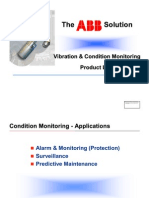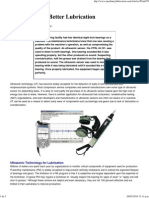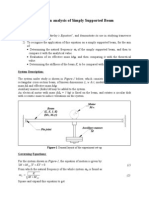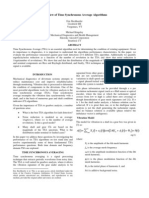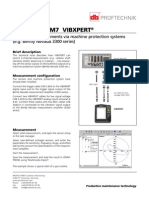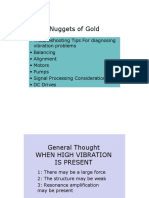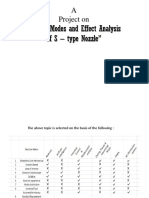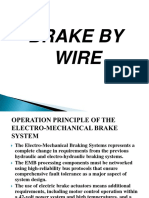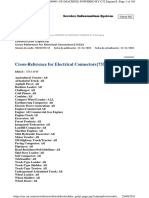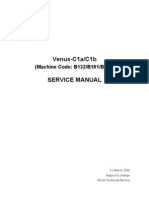History of Vibration Analyzers
History of Vibration Analyzers
Uploaded by
CrusherjpCopyright:
Available Formats
History of Vibration Analyzers
History of Vibration Analyzers
Uploaded by
CrusherjpCopyright
Available Formats
Share this document
Did you find this document useful?
Is this content inappropriate?
Copyright:
Available Formats
History of Vibration Analyzers
History of Vibration Analyzers
Uploaded by
CrusherjpCopyright:
Available Formats
The Real History of Real-Time Spectrum Analyzers
A 50-Year Trip Down Memory Lane
Joe Deery, AIM & C, Newfoundland, New Jersey
Joe Deery began his technical career in the U.S. Navy, achieving the rate of E6 as an electronics technician in four years. He was the lead technician on a ship that controlled troop landings with millions of dollars of equipment. Double Bachelors Degrees (in Electrical Engineering and Chemistry) followed the Navy experience. After eight years as a Calibration Engineer at General Electric and one year as a Systems Engineer with RCA on the Ballistic Missile Early Warning System (BMEWS) program, he decided to make a career change. In his own words I began a life of selling sophisticated dynamic measurement instrumentation, this included RTAs as a rep with Scientic Devices and J. E. Cuesta & Co. in the Pennsylvania-New Jersey area. Subsequent sales management positions included the sunny days as Sales Manager at Pulse Dynamics, VP of Sales at Nicolet Scientic, Sales Manager at Ballantine Labs, General & Sales Manager at Noise Unlimited and Sales Manager at LeCroy. The suns brilliance then diminished; I joined the dark side and became a Regional Sales Manager for Data Physics. Today, my rep company, AIM&C (www.aimcrescentbay.com), sells dynamic testing systems, instrumentation and transducers to the test and measurement community. We also sell thermal oxidizers, tanks, valves, piping, reactors and more to the chemical processing industry. Real-time spectrum analysis is used to predict and analyze mechanical faults and failures in rotating machinery to analyze vibratory motions of components, systems and structures; to analyze the noise constituents in these systems; and for many other purposes. Real-time spectrum analyzer (RTA) development has a 50-year history that involves overcoming numerous technical barriers, challenging measurement techniques and physical obstacles. This article travels down memory lane from the earliest days in the development of these instruments at the Applied Research Laboratories of Columbia University to some of the latest product offerings. The many individuals that have contributed to this history and their accomplishments are chronicled. In 1957 the US Air Force accepted delivery of a real-time spectrum analyzer with a Coherent Memory Filter system from researchers at Columbia University. This instrument simulated a bank of parallel lter/detectors, providing the constant-bandwidth spectrum of an applied analog input signal. This rst RTA was implemented using glass acoustic delay lines and provided real-time processing from less than 1 Hz to 40 kHz. A commercial enterprise, Federal Scientic Corporation, was spun off to develop this exciting new technology. It was founded by Henry Bickel, Reinhold Vogel, Joe Flink, Art Citrin, Mike Laviola and Bill Brookner and located at 615 West 131st Street in New York City. They obtained a patent on the Time-Compression methodology that allowed a single lter and heterodyning electronics to produce a spectrum in real time. 54
SOUND AND VIBRATION/JANUARY 2007
Artwork from Nicolet Application Note 11: How to Balance with your RealTime Analyzer drawn by Lee Bjong in 1977.
Three wise men of the East: Henry Bickel, Arthur Pini, Reinhold Vogel.
A wise man of the West: Tony Keller, early USAF White Sands Federal Simoramic user, eventual Vice President of Spectral Dynamics.
The name Coherent Memory Filter gave way to Simoramic and eventually to the familiar trademark, Ubiquitous (thank you, Dick Rothschild). Early Federal Scientic employees developed and rened the time-compression or deltic RTA.
www.SandV.com
HP 5451C System used by Dave Formenti at the GM Proving Ground Noise and Vibration Laboratory. The NVL also simultaneously employed other unsavory characters including Don Kientzey, Ken Ramsey, George Fox Lang and (trust us on this) Michael Nyquist!
The Simoramic Analyzer.
1960s Developments
The first commercial RTA from Federal Scientic was the UA-7 Ubiquitous Spectrum Analyzer. The engineering team had blinders on when it came to mechanical applications and they only projected the sale of about 100 sets to Federal Scientic UA-7. Electronic Warfare and military customers. Spectral Dynamics, under the direction of Laurie Burrows and Hugh Ness, realized the breakthrough that Federal Scientic had made and entered into a license agreement to produce a product equivalent Spectral Dynamics SD301. to the UA-7, which ultimately became the SD 301. These early RTAs processed data up to 20 kHz through a single lter that acted as 500 lters in 50 msec. These systems had street sale prices in the $35,000 range. While it licensed the UA-7 to Spectral, Federal had an improved model under development. This was introduced (interestingly) as the UA-6 and featured a greater frequency range to 40 kHz. Spectral was furious about this new product offering from Federal, and a legal battle ensued. Spectral placed the highest level of engineering technology on developing RTAs for the environmental testing, rotating machinery, automotive and related markets. Federal/Spectral sales arguments included debating the benet of dithering the ADC with random noise and a 2 dB difference in dynamic range (48 to 50 dB). Other scientists who performed work with the group at Columbia University started Saicor, which was ultimately acquired by Honeywell. Another company, EMR Hatboro, introduced an analyzer that held a spot on the stage into the 70s for about four to ve years. Multiple window functions were its claim to glory. Princeton Applied Research, which was known for its boxcar integrators, branched out and developed an RTA as well. At this time, 85% of the RTA commercial market was divided between Spectral Dynamics and Nicolet Scientic, which purchased Federal Scientic. The lions share of sales was registered by Spectral. Spectral made a major breakthrough for the U.S. Navy. They
www.SandV.com
integrated an RTA and special waterfall display hardware with passive sonar to produce the AN/BQR-20 system. This sonar analysis system (and its successors) became standard tactical equipment on all U.S. submarines. Spectral Elements of the AN/BQR-20: Spectral sold many hundreds over a SD301 analyzer, SD13151 Spectroten to fteen year period. The gram Display Control. SD13151 waterfall display was designed by Carl Dubois for sonar applications. Federal made a half-hearted effort to get into the submarine sonar business with little success. Their sh-bowl advertisement raised the Navys ire and had to be quickly withdrawn to preserve good working relationships with the many Navy laboratories Federal serviced. However, they did contribute directly to the submarine sonar effort by innovating a new instrument called a Frequency Translator. The Frequency Translator The infamous Federal sh bowl adwas an accessory for an RTA. vertisement. It used analog up/down heterodyning to accomplish what is now called Zoom spectral analysis. The translator allowed the RTA to analyze a narrow frequency band with very high resolution. In 1965, Cooley and Tukey at Princeton University published their historic paper on the computation of the FFT. This development allowed Control panel of Time/Data 100. a 1024 point FFT transform (512 lines) to be processed in one one-hundredth of the time previously required. It required 50% less memory to complete the computation. Time Data, a California company resulting from the creative engineering efforts of Ed Sloan and Bruce McKeever and the creativity of Charlie Heismann and others, designed the rst commercially available FFT system in 1967. Their Model 100 system, which was housed in two 6-ft racks, set the stage for the FFT analyzers that are available today. It processed a 1024 point transform in 1 sec. Time Data followed with the Model 90, which provided a speedup of the transform computation in a minicomputer. Later, in 72, Time Data introduced its model 1923 based on a PDP-11
40th ANNIVERSARY ISSUE
55
Nicolet OF-400B Dual-Channel FFT Analyzer.
DEC minicomputer. The U.S. Air Force took delivery of the rst Time Data 100 system. A later Time Data 100 was delivered to FAA/NAFEC facility; its acceptance was based upon matching spectra with a Federal Scientic RTA Model UA-14, a 400-line MINI_ UBIQ analyzer. IRD marketed the Federal Scientic UA-14 behind a green front panel. The General Radio Company subsequently purchased Time Data and continued sales and engineering development. The Hewlett Packard DSA Division in Santa Clara, CA under the leadership of Ron Potter, Ago Kiss and Pete Roth followed with the 5450/5451. These systems enjoyed fantastic sales success. Bill Cosby promoted the Model 5451 in automotive TV ads that showed structural vibration patterns. HP also sold hundreds of the Vibration Control System Model 5427 based on its FFT analyzer development.
Boy with toy: George Fox Lang with Nicolet 660 FFT.
1970s Developments
In 1974 Nicolet launched the OF-400 Omniferous dualchannel FFT analyzer with another Rothschild-invented trade name. It had a bandwidth Federal Scientic UA-500. of DC to 100 kHz, a 10 kHz realtime rate, phase and amplitude-matched 120 dB/Octave analog anti-aliasing filters, 12-bit digitizers and a dynamic range of 72 dB. The real-time rate in the single channel mode was 20 kHz; the system processed a 2048 point transform in 30 msec. The OF-400 was Spectral Dynamics SD 330. portable since it was in four boxes with a power supply that alone weighed at least 85 pounds and a total system weight of 220 pounds. Spectral Dynamics had a similar solution under development, but lost the race to the market. The SD 360 was a very capable and competitive FFT analyzer. In the mid-70s the RTAs continued to sell in decent numbers in the marketplace. Both Nicolet and Spectral developed analyzers that helped enhance the RTAs impact. First Nicolet developed the UA 500, a 500-line RTA with 100 kHz bandwidth and 10 kHz Nicolet Scientic 440A Mini-Ubiquireal-time rate. The instrument tous FFT analyzer. was smaller than the UA6/301 analyzers and included the averager. It offered digital outputs to graphing calculators available at that time. Spectral developed the SD 330, whose specications were not 56
SOUND AND VIBRATION/JANUARY 2007
equivalent to the UA 500, but it had a built-in display with a significant benefit in size and weight reduction. This analyzer became a workhorse in rotating machinery applications. Nicolet rocked the market in 1975 with the first truly portable (30-lb) single-channel FFT analyzer. The 440A Mini Ubiquitous had 400-lines with a built-in display. For a period of approximately seven years, Nicolet delivered 30 to 45 of the 440, 444 and 446 analyzers per month. The average cost was $13,500/system. Many of the instrument manufacturers were feverishly developing portable two-channel FFTs with the 5420 from HP leading the pack. Nicolet followed with the Model 660 and about 12 months later Spectral delivered the SD 375. Spectral sold many of the SD 375 analyzers, as they had with time compression, to the mechanical and military markets. All in all, HP sold more two-channel analyzers than its competitors combined. Ono Sokki, Takeda Riken and other foreign suppliers entered the market in the 70s with imitations of the SD, Nicolet and HP products. Hewlett Packard introduced the worlds rst dedicated modal analysis instrument, the HP 5423.
Last of a series, the Nicolet 446A.
HP 5420A FFT Analyzer.
SD 375 FFT Analyzer.
1980s Developments
The real shock came from HP in the early 80s, with a HP 3582A. product offered from the Loveland Division. The HP 3582 was a compact two-channel analyzer with zoom and a bandwidth to 20 kHz for a price under $11K. The HP 3582 used four HP-manufactured SOS chips to perform zoom analysis; competitive instruments used 250 to 300 ICs for B&K 2032. the same function. Limited memory and reduced processing speed produced slower 250 line
www.SandV.com
Hewlett Packard 3565S Paragon system.
based upon their software, measurement hardware made in Holland by DIFA, and HP 1000 mini-computers running Unix. National Instruments entered the analysis market with plug-in FFT hardware and software as part of its LabVIEW suite of products. National made high channel-count PCbased systems affordable. Former HP employees Sri Welaratna and Dave Snyder founded Data Physics in 1983. The rst Data Physics product was a DOS computer-based vibration controller. In 1989, Data Physics ACE. they introduced the DP 420, which consisted of a board set in the computer to process up to 16 input channels. An advantageous benet of the design was that the same hardware could be used for analyzers and controllers, and the software suite dictated the performance characteristics of the system. Hewlett Packard Company entered the modular analysis business with the introduction of its HP 3565S Paragon system. A rack of multi-channel input and source modules was controlled by an HP-9000 workstation running HP-UX (Unix) and Vista application software. The concept proved very popular with large organizations.
Developments in the 1990s
From the early 90s a user of FFT analyzers had choices from among a number of suppliers including HP, Stanford Research, B&K, Zonic, Tektronix, CSI, Larson Davis, Data Physics, DLI, DSP Technology, LMS, Wavetek, Rockland and others. Hewlett Packard Company introduced modular VXI multi-channel hardware, starting with the 1432A module in 1992. The concept was expanded to span from DC-88 kHz and 8 to 1000 channels using modules of 8 or 16 inputs. LMS acquired Skalar GMBH and DIFA Measurement Systems. They ventured with HP to provide CADA-X software support for the Hewlett Packard VXI hardware. Wavetek acquired Rockland, and eventually Nicolet Scientic. Spectral Dynamics was purchased by Scientic Atlanta. Spectral was then repurchased by a group of people who merged it with the GenRad FFT group. Due to internal management problems and loss of market share, Wavetek Scientic ceased production during this period. Today the product line is owned by Ballantine Laboratories, which only performs repairs on these ancient systems. Tektronix abandoned the FFT analyzer market in 1993 to concentrate on oscilloscopes. DSP Technology was bought by MTS and its FFT analyzers sold to Spectral Dynamics. Microsoft Windows and UNIX replaced DOS operating systems in the computers utilized to process the FFT. Dactron, founded by James Zhuge who left Data Physics, entered the market in the late 90s with FFT analyzers and vibration controllers. The major market entries in the mid-90s included FFTs from B&K, HP, Dactron, 01dB, LMS, Nicolet (Madison, WS), Spectral Dynamics, Oros, Ono Sokki, Zonic, Stanford Research, Data Physics, National Instruments and others. Data Physics introduced the ACE 2-channel PCMCIA spectrum analyzer with 100 dB of dynamic range and 20 kHz of real-time bandwidth. This FFT set the standard in price/performance capability with a complete system price of $3,950. As the decade closed, the Hewlett Packard Company was divided into two entities. Inexplicably to old-timers, the HP name went with the new PC/commodity-hardware business while the old-line instrument business was forced to re-establish itself under the trendy new name, Agilent.
40th ANNIVERSARY ISSUE
HP VXI modules.
transforms than competitive systems. This did not impede sales, and HP sold four times more than any other company offering FFT analyzers. The box business carried the market through the mid 80s. Emergence of applicationspecific analyzers for modal testing and acoustics (B&K 2032 for example), signature analysis of rotating machinery and shaker control dominated the market. The B&K 2032 was the rst to incorporate a large buffer memory allowing for the Data Physics DP 420. re-analysis of captured data. General Radio, renamed GenRad in the 70s, introduced the rst FFT analyzer to use a raster-scan display. Employees Dick Benson, Paul Mennen, Loren Enochson and George Smith wanted to build a PC-based FFT analyzer/vibration controller. GenRad did not approve the project, believing that PCs would not be accepted in the test and measurement world. The team left to form SIGnology, and the era of PC-based instrumentation was born when the SP-20 FFT analyzer was introduced in 1985. Tektronix got into the FFT analyzer business when it purchased SIGnology in 1987 and relabeled the SP-20 as the 2630. Tek followed with the 2624A, a 200 kHz bandwidth FFT analyzer. In Europe, LMS was formed in Belgium. Government support allowed a group of professors to spin-off from the Katholieke Universiteit Leuven (KUL) and form a commercial business focused upon modal analysis. They developed and marketed systems
www.SandV.com
57
Brel & Kjaer Pulse mainframes and modules.
The 21st Century
Acquisitions and mergers of RTA manufacturers continued into the 21st century. Ling Dynamic Systems (LDS) purchased Dactron and Nicolet Instrument (Madison, WS). IOtech purchased Zonic, thereby Spectral Dynamics Cougar. adding FFTs to its data acquisition instrumentation line. PCB purchased Larson Davis. Modular multi-channel FFTs with higher real-time bandwidths (up to 100 kHz) and 24-bit digitizers supporting dynamic range of 120 dB or better dominate the market LDS/Dactron Focus. entries. Connectivity via a number of portals including USB, FireWire and Ethernet integrates computers, replacing older RS232 and IEEE488 interfaces. The inclusion of a transducer database and TEDS support for automatic entry of transducer sensitivities are also key selling features of LMS SCADAS Mobile. these powerful instruments. We have watched the progress of the PC industry refocus the RTA business. Rapid changes in popular desktop and laptop congurations have driven spectrum analyzer and vibration controller manufacturers back to the far end of a wire. USB, Ethernet and FireWire are currently viable means of integration. ISA and PCI card formats are now antiquated and fat (type III) PCMCIA modules nd it hard to nd a slot. In short, the instruments have been physically driven back out of the PC while the need for their tight integration with it have been enforced. Recent software from Vibrant Technology has, perhaps, shown us where the future will really reside. Their MEscopeVES application has now been outtted with a series of acquisition options that allow hardware from 15 (list growing) different manufacturers to gather data for structural analysis. Suddenly, a broad range of equipment including signal analyzers, DAC cards, digital data recorders and vibration controllers can act as the measurement front-end for modal testing and related activities. More importantly, the operators interface remains the same regardless of what piece of hardware is employed. The economic implication is enormous: train your people for the application, not for the vendors hardware selected to perform it. Wow! Look for wireless linkages to take on greater importance and plan on taking FFTs as well as pictures with your cell-phone in the not too distant future!
MEScopeVES uses Vibration Research 8500 shaker-controller to acquire impact data.
Personal Proclamations
The Father of the RTA, in my opinion, is Henry J. Bickel with 58
SOUND AND VIBRATION/JANUARY 2007
strong parenting rights given to the entire Federal Scientic team. Mr. Bickel is currently the Vice President of Business Development for LeCroy Corporation. Laurie Burrows and the crew at Spectral Dynamics had the rst real insight into the role of the RTA in the mechanical testing marketplace and deserve recognition for their vision. Mr. Burrows is performing structural analysis on heavens pearly gates and probably on a number of other heavenly bodies. Few curmudgeons besides the author still practice in the business today. The two old guys I can think of who could step up to and use a time-compression real-time analyzer are Tony Keller, International Sales Manager for Spectral Dynamics and George Fox Lang, irascible Associate Editor of this magazine. The customer group cited for recognizing the value of the RTA for solving rotating machinery problems used to gather at the E.I. Dupont Experimental Station. This since dissolved group of approximately 25 engineers included Dr. Larry Mitchell and Dave Mellon. Today, DuPont monitors the machinery signatures of its plants throughout the world in real time from Wilmington, DE. Larry Pharo and his associates at Penn State University ARL are cited for their work in submarine signature recognition and U.S. ship silencing using RTAs creatively through the 60s and 70s. The Capo di tutti capi of the Modal Maa will always be Dr. Dave Brown. The University of Cincinnati remains the epicenter of modal activity and Dr. Randy Allemang carries the reins of his retired associate with consummate skill. Dr. Mark Richardson, Dave Formenti, Don Kientzy and Ken Ramsey founded Structural Measurements Systems (SMS), a company that led the way in solving structure problems by developing software supporting HP FFT analyzers. Mr. Formenti wrote the modal code for the HP 5423. Dr. Richardson invented the worlds nest modal parameter curve-tter and is currently the President of Vibrant Technology. The late Dr. Jason Lemon and Dr. Al Klosterman at SDRC are recognized for their early development of modal parameter identication utilizing swept sine methods and later with FFT-based random techniques. The top factory RTA sales engineer was Jack Heeg who sold for Nicolet and B&K. Mr. Heeg lived in Ohio and sold throughout the Midwest for more than 25 years before losing his battle with cancer. The Spectrum Analyzer Museum at Ohio State University, developed under the direction of Dr. Donald Houser, cites Mr. Heeg as the inspiration for the project. Review the museums offerings at www.spectrumanalyzer.org. Dr. Houser accepts old RTA donations to add to the Ohio State collection. The legendary Lionel Swartz, sold numerous spectrum analyzers throughout the Midwest, especially in Motown. Lionel is named the top real-time analyzer sales representative. His arch opponent in the Detroit sales arena, Dick Merrill of Spectral Dynamics, is also recognized for his sales numbers. Dick, did you save Lionels condolence cards from those lost orders? Joe Cuesta, a legendary RTA sales representative for Spectral Dynamics, at one time received commissions for every GSA RTA
www.SandV.com
sale to Spectral from anywhere on the globe. B&Ks Tony Schneider is recognized for his presentation ability; he made FFTs easy to understand with creative slide shows. His Little Brown Book, published by Sound and Vibration for the Case Alumni Association, is a classic. A tip of the hat to Kathy Sullivan who showed the boys how to sell RTAs in the 70s. Kathy retired from A.T.&T. with the title of President. Gents, eat your hearts out! Dean Dawson, a West Coast economist, salesman, analyzer repairman, philosopher and writer sold for many manufacturers. He is recognized for his unique sales and repair skills. Dean was one of the top sales producers of RTAs for more than 25 years and developed technical blarney to a ne art. Thumbs up to Ted Lisbon, the Souths super FFT salesman from Atlanta, who has sold analyzers for more than 30 years. Ted started his career with B&K, hit his stride with Nicolet and is now president of Microspec, Inc. Ask Ted to tell you the story of his strong-arm tactics while retrieving an FFT for its rightful owner. Frances Jacques Perdriat deserves special mention for selling serial number one of almost everything built by Federal and Nicolet Scientic. Not only did Jacque sell superlatively, he personally repaired anything and everything that failed in France or Switzerland. Englands Andy Campbell was the Nicolet U.K. manager and consummate party animal. Who else regularly ew on the Concord, had a company boat (Nicolet Belle) or company-sponsored race horse? Dispite the infamous shbowl ad, Andy produced an unbelievable volume of orders from the U.K. Navy. Charlie Jackson (Monsanto) is recognized for his seminar presentation skills describing complex rotating machinery problems in simple, easy-to-understand, language wrapped around some anatomy studies. Charlie, we want a repeat and a lengthy review of Slide #10 and Slide #20. Hundreds of vibration analysis engineers and technicians owe a big thank-you to one of the founders of IRD, Dr. Arthur Crawford. His free telephone help in solving numerous rotating machinery problems goes well beyond being a good guy. Art, you are not only a good guy, you are also one great individual that I am proud and happy to know. The entire industry owes a thank-you to Dr. Ron Eishelman founder of the Vibration Institute, to Henry and Sally Pusey and to Jack Frarey for their work with SAVIAC and MFPT. Recognition is due his supreme editorship Jackson Krueger Mowry for his steadfast dedication to the industry publishing Sound and Vibration during four decades of this exciting period for RTA users. Hundreds of design, application and sales engineers owe a debt of gratitude to Jack.
Acknowledgements
Without the inputs and encouragement of these professionals this trip down memory lane would not be a true and accurate presentation. Dr. Don Houser Ohio State University Reinhold Vogel Retired Sr. V.P. Engineering of Federal and Nicolet Scientic George Fox Lang former Nicolet Scientic V.P. Anton C. Keller Permanent Chief Cook & Bottle Washer, Spectral Dynamics Dr. Susan Hough Independent Consultant (Tektronix) Dr. Tom Miller NU Laboratories
References
Cooley, J. W., and Tukey, J. W., An Algorithm for the Machine Calculation of Complex Fourier Series, Mathematics of Computation, Vol. 19, 1965. Weleratna, S., Thirty Years of FFT Analyzers, S&V Observer, Sound and Vibration, Jan 1997. Theissen, A. E., The History of the General Radio Company, General Radio Company, 1965, PDF available at www.teradyne.com/corp/grhs/ pdf/ThiessenHist.pdf. Authors Note Thoughts expressed in this article were initially presented as a featured paper at the 57th meeting of the Society for Machinery Failure Prevention Technology and as well at Vibration Institute Chapter meetings and meetings of other technical groups. The author may be contacted at: winwin@tellurian.com.
www.SandV.com
40th ANNIVERSARY ISSUE
59
You might also like
- Nomadic Furniture 3.0Document7 pagesNomadic Furniture 3.0Nedim MutevelicNo ratings yet
- Vibration Based Damage Detection (VBDD) - Case StudyDocument16 pagesVibration Based Damage Detection (VBDD) - Case StudyAshokNo ratings yet
- Correlation Between Belt Natural Frequencies and Vibration SpectraDocument7 pagesCorrelation Between Belt Natural Frequencies and Vibration SpectraSrinivasan RaviNo ratings yet
- 60PP9100D 37Document121 pages60PP9100D 37Miguel VargasNo ratings yet
- MPLab Installation V889Document11 pagesMPLab Installation V889Janine AdamsNo ratings yet
- Story of Vibration AnalysisDocument14 pagesStory of Vibration AnalysisCrusherjp100% (2)
- Tutorial Diagnostics Randall PDFDocument84 pagesTutorial Diagnostics Randall PDFkfathi55No ratings yet
- CM3152 en SKF Idler Sound MonitorDocument4 pagesCM3152 en SKF Idler Sound MonitorLuisSilvaNo ratings yet
- VibMatters-August 2016 PDFDocument6 pagesVibMatters-August 2016 PDFshakerNo ratings yet
- Basic Vibration CourseDocument24 pagesBasic Vibration Coursewijaya1234No ratings yet
- Wavelet Transform Byruby PalekerDocument17 pagesWavelet Transform Byruby PalekerSujeet SharmaNo ratings yet
- Machinery Fault DiagnosisDocument45 pagesMachinery Fault DiagnosisAhmed El TayebNo ratings yet
- CEP VFD ManualDocument234 pagesCEP VFD ManualUsama ZubairNo ratings yet
- Detect Soft Foot With Vibration AnalysisDocument4 pagesDetect Soft Foot With Vibration AnalysisJaime BerryNo ratings yet
- VibMatters Current Issue PDFDocument16 pagesVibMatters Current Issue PDFjuancgr77No ratings yet
- Successful Solution: To The Challenge ofDocument2 pagesSuccessful Solution: To The Challenge ofKenny RuizNo ratings yet
- Time Waveform Analysis TechniquesDocument2 pagesTime Waveform Analysis TechniquesManel Montesinos50% (2)
- Vibration & Condition Monitoring Prod Line - Topic OneDocument27 pagesVibration & Condition Monitoring Prod Line - Topic Onejj127No ratings yet
- Fan VibrationsDocument167 pagesFan VibrationspetrilliNo ratings yet
- Vibration SwitchesDocument12 pagesVibration SwitchesAnonymous 1dVLJSVhtrNo ratings yet
- Rolling Element Bearings Vibration AnalysisDocument10 pagesRolling Element Bearings Vibration AnalysisSiva Kulanji100% (1)
- Fluke 810Document148 pagesFluke 810Dwiki Juniarto HadiNo ratings yet
- Emerson - Cooling Tower Vibration Sensors - WirelessDocument8 pagesEmerson - Cooling Tower Vibration Sensors - WirelessCandida MorvinNo ratings yet
- Ultrasound For Better Lubrication PDFDocument5 pagesUltrasound For Better Lubrication PDFperdid0No ratings yet
- Pitfalls in The Analysis of Machinery Vibration MeasurementsDocument7 pagesPitfalls in The Analysis of Machinery Vibration MeasurementsTheerayoot PoomchaiNo ratings yet
- C E R M: Ertification XAM Eference AterialDocument10 pagesC E R M: Ertification XAM Eference AterialMarco AntonioNo ratings yet
- An Introduction To Time Waveform Analysis: BiographyDocument21 pagesAn Introduction To Time Waveform Analysis: BiographyAbolfazl KhakiNo ratings yet
- Vibration Monitoring of Paper Mill MachineryDocument17 pagesVibration Monitoring of Paper Mill Machineryerick giovanniNo ratings yet
- Nova-PeakVue Rev B2 PDFDocument2 pagesNova-PeakVue Rev B2 PDFAlejandro José Poveda GuevaraNo ratings yet
- VibMatters September 2016 Final DownloadDocument7 pagesVibMatters September 2016 Final DownloadfazzlieNo ratings yet
- Vibration Analysis of SS BeamDocument4 pagesVibration Analysis of SS BeamRam_Charan_8818No ratings yet
- A Review of Time Synchronous Average AlgorithmDocument8 pagesA Review of Time Synchronous Average AlgorithmEric BechhoeferNo ratings yet
- CAT II - EMMU 7241 - Machine Tool Vibrations and Cutting Dynamics-Marking SchemeDocument14 pagesCAT II - EMMU 7241 - Machine Tool Vibrations and Cutting Dynamics-Marking SchemeCharles OndiekiNo ratings yet
- HPC WheeBoxDocument170 pagesHPC WheeBoxashutosh9gaikwadNo ratings yet
- Vibration Signature of Defected Gear Tooth Using Spectral AnalysisDocument8 pagesVibration Signature of Defected Gear Tooth Using Spectral AnalysisHURRYSTARNo ratings yet
- Peakvue CaseDocument22 pagesPeakvue CaseNeopeakNo ratings yet
- Vibration Analysis of Gear Box.5-MilosprokoDocument3 pagesVibration Analysis of Gear Box.5-MilosprokoRavikiran Hegde100% (2)
- Mobius Vibration Analysis Global Skill ShortageDocument8 pagesMobius Vibration Analysis Global Skill Shortageaal_shurafaNo ratings yet
- Rev.0 CSI 2600 PDFDocument170 pagesRev.0 CSI 2600 PDFAnonymous srwHCpANo ratings yet
- Balancing Tip # 105 C D International, IncDocument3 pagesBalancing Tip # 105 C D International, IncAnonymous PVXBGg9TNo ratings yet
- Peakvue Case History 2Document9 pagesPeakvue Case History 2ben_ramatlaNo ratings yet
- Introduction To Time Waveform AnalysisDocument19 pagesIntroduction To Time Waveform Analysismustafa100% (1)
- Analyzing and Resolving An ID Fan Failure Due To Torsional VibrationDocument16 pagesAnalyzing and Resolving An ID Fan Failure Due To Torsional Vibrationsatya krishna chagantiNo ratings yet
- Using PeakVue Plus Technology For Detecting Anti Friction Bearing FaultsDocument11 pagesUsing PeakVue Plus Technology For Detecting Anti Friction Bearing Faultseko bagus sunaryo100% (1)
- WEG Medium and High Voltage 3 Phase Induction Motors Br632 Brochure EnglishDocument12 pagesWEG Medium and High Voltage 3 Phase Induction Motors Br632 Brochure Englishmohammad hazbehzadNo ratings yet
- TOMAS UsersManualDocument94 pagesTOMAS UsersManualrodruren01No ratings yet
- Adre BrochureDocument12 pagesAdre BrochurenuesteNo ratings yet
- Cepstrum Analysis and Gearbox Fault Diagnosis - Bruel and Kaer PDFDocument21 pagesCepstrum Analysis and Gearbox Fault Diagnosis - Bruel and Kaer PDFbackvlackoNo ratings yet
- Paper Rotor DynamicsDocument12 pagesPaper Rotor DynamicsTony HeNo ratings yet
- Turbo Machinery Operation and MaintenanceDocument2 pagesTurbo Machinery Operation and MaintenanceNirmal SubudhiNo ratings yet
- TN 13 Omnitrend ShortcutsDocument2 pagesTN 13 Omnitrend ShortcutsBrtonNo ratings yet
- Shock Pulse MeasuringDocument4 pagesShock Pulse MeasuringyancNo ratings yet
- Back To Basics CMVA 4Document24 pagesBack To Basics CMVA 4Le Thanh HaiNo ratings yet
- TN 7 VibxpertDocument1 pageTN 7 VibxpertBahtiar YudhistiraNo ratings yet
- Canadian Machinery Vibration AssociationDocument17 pagesCanadian Machinery Vibration AssociationsatfasNo ratings yet
- Airborne & Structure-Borne Ultrasound As A Key Component of Predictive MaintenanceDocument27 pagesAirborne & Structure-Borne Ultrasound As A Key Component of Predictive MaintenanceSaliya RathnayakeNo ratings yet
- NuggetsDocument202 pagesNuggetsfazzlieNo ratings yet
- "Failure Modes and Effect Analysis of S - Type Nozzle": A Project OnDocument15 pages"Failure Modes and Effect Analysis of S - Type Nozzle": A Project Onuujaval pavar100% (1)
- Data Sheet For CMVA55Document2 pagesData Sheet For CMVA55Oleg1142No ratings yet
- Detecting Rolling Element Bearing Faults With Vibration AnalysisDocument20 pagesDetecting Rolling Element Bearing Faults With Vibration AnalysiscatraioNo ratings yet
- Case Studysf - 71700bDocument174 pagesCase Studysf - 71700bRajagopal SNo ratings yet
- Rev.7 RBMview PDFDocument226 pagesRev.7 RBMview PDFLuis VizcardoNo ratings yet
- Online Bus Reservation System Project ReportDocument62 pagesOnline Bus Reservation System Project Reportcarter sNo ratings yet
- MP200 User ManualDocument1 pageMP200 User ManualLucas YuriNo ratings yet
- Brake by Wire1Document21 pagesBrake by Wire1AdilNo ratings yet
- A330 RR Trent 700 T7lm05r80-Ata-73 & 76Document36 pagesA330 RR Trent 700 T7lm05r80-Ata-73 & 76Shusant SahaNo ratings yet
- Host Configuration: DHCP: TCP/IP Protocol SuiteDocument19 pagesHost Configuration: DHCP: TCP/IP Protocol SuitekentNo ratings yet
- Lecture#8-Instruction Set Architecture - 012458Document17 pagesLecture#8-Instruction Set Architecture - 012458ALINo ratings yet
- MameDocument9 pagesMameSergio AgostiniNo ratings yet
- Conectores Caterpillar PDFDocument101 pagesConectores Caterpillar PDFJuan Carlos Callas GarayNo ratings yet
- Retail Solution With Cit FeaturesDocument2 pagesRetail Solution With Cit Featuresmarco.valdez1989No ratings yet
- Datablad Reservedele DDocument54 pagesDatablad Reservedele DDanilo CamargoNo ratings yet
- Flash Recovery Area - Space Management Warning & Alerts (ID 305812.1)Document5 pagesFlash Recovery Area - Space Management Warning & Alerts (ID 305812.1)surendra82No ratings yet
- 2012 SLK 350 3.5 V6 (M276 Engine) Spark Plug ReplacementDocument17 pages2012 SLK 350 3.5 V6 (M276 Engine) Spark Plug ReplacementIgor_Predator100% (3)
- Practical Manual: Electrical Machine LabDocument4 pagesPractical Manual: Electrical Machine LabSurajMauryaNo ratings yet
- Ugly Choke BalunDocument8 pagesUgly Choke BalunPraba Karan DNo ratings yet
- IT441 - Multimedia SystemsDocument257 pagesIT441 - Multimedia SystemsJay Ann G. Angyoda100% (1)
- Caviar Green Specifications (English)Document3 pagesCaviar Green Specifications (English)dibaladaNo ratings yet
- Assignment 4Document5 pagesAssignment 4Muhammad UmairNo ratings yet
- SOP 10. LabView Data Acquisition ProgramDocument7 pagesSOP 10. LabView Data Acquisition ProgramMaqsood AhmedNo ratings yet
- Twistlock TestingDocument44 pagesTwistlock Testingkandahar_specNo ratings yet
- VPN With HSRP High AvailabilityDocument7 pagesVPN With HSRP High AvailabilitydolbouNo ratings yet
- Sensor Solutions BR-2016Document56 pagesSensor Solutions BR-2016carlosve87No ratings yet
- Allegro 2 Operator's ManualDocument115 pagesAllegro 2 Operator's ManualGustavoNo ratings yet
- Model v-C1 Manual Only FinalDocument935 pagesModel v-C1 Manual Only FinalRui QuintelaNo ratings yet
- Closures: Evolant Solution Products Product DescriptionDocument68 pagesClosures: Evolant Solution Products Product DescriptionKen NethNo ratings yet
- Bayo Net FuseDocument4 pagesBayo Net FusebhaskarinvuNo ratings yet
- Cylinder Head Valve & Cylinder Piston MotoDocument23 pagesCylinder Head Valve & Cylinder Piston MotoDeysi CardenasNo ratings yet
- Manual AngiografoDocument528 pagesManual AngiografoAlex RiascosNo ratings yet

















